Perhaps the most asked question as we launched The Amsterdam Produce Show and Conference was why Amsterdam? After all the bulk of the industry is in Rotterdam or Westland.
Well we saw it as having the best of both worlds. Launching an event in Amsterdam, meant we were launching an event in the great iconic city of the Netherlands. Recognized as a hub of trade and font of innovation for hundreds of years, it is clearly the place that travelers from the Americas, Asia, Africa, etc. all want to visit.
Yet because Holland is compact visitors also could easily visit the massive port and trading centers in Rotterdam and production points throughout the country. Indeed one of the tours that is part of the show is a visit to a top class storage and logistics operation located in the Port of Rotterdam, the Agro Merchants Group.
We wanted to get more insight into what visitors will experience as they traverse both Amsterdam and Rotterdam, so we asked Pundit Investigator and Special Projects Editor Mira Slott to pay a visit. Here is her report:
The excitement began soon after arriving at my hotel in Amsterdam’s vibrant, historic and hip city center for a pre-show visit.
A thunder of gun shots and people screaming overtook the area. The magical canal-laden scene was completely blockaded off, and typical traffic, including a constant stream of bicyclists, was being redirected to alternative winding, narrow side streets by movie crews. Today they were filming The Hitman’s BodyGuard with actors Ryan Reynolds, Samuel L. Jackson and Selma Hayek.
Befriending production staff to maneuver my way through the strategically placed barriers, I got to watch Samuel L. Jackson in a speed boat being chased down the canals by evil foes; then he was relentlessly shot at from above by shady characters swirving on motorcycles and atop a scary tank contraption, with pretend tourists screeming on the bridges. Take 2, Take 3…reshooting until sundown, with stuntmen returning the following week for more action.
Amsterdam is a popular movie site, and the city relishes a mixed love affair with movie studios and celebrities as it gains monetary compensation and creates promotional intrigue to increase tourism, but at the same time commercialization disturbs the old-world charm, according to diehard Amsterdam locals.
Navigating the cornacopia of produce-filled wonders in Amsterdam included a taste of the burgeoning food truck phenomomon traveling across the Netherlands. Luckily, I was able to catch a lively and delicious TREK Food Truck Festival taking over Amstelpark late into the night. Global produce fare abounded; at the Verboden Fruit truck, employees pounded coconuts and squeezed fresh citrus drinks; Firma Pickles, Burgers & Wines, a double-decker truck with flashing lights, touts multiple restaurants around Holland using only organic ingredients; Aubergine Caravan innovated eggplant recipes with Israeli/East European flavors, creating layered eggplant slices to snack on like potato chips. Mister Maisguy offered grilled classic buttered corn, a Mexican variety with cheese, chile pepper, coriander and lime, and a Jamaican version with fresh ginger, cinnamon and lime.

A father lifted up his son to gleefully grab a twisted potato chip stick, which was nearly his height — another food truck produce treat for this local Dutch visitor.

For contrast, FoodHallen Amsterdam is a newer more upscale street food concept. The indoor restaurant market looks to broaden market appeal to a more international, metropolitan customer base.
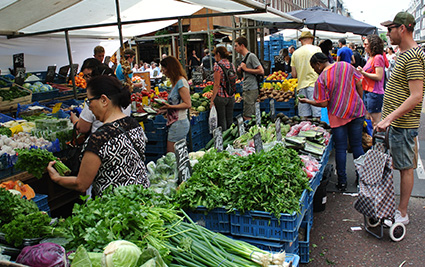

I can attest that it’s best to visit the sprawling, eclectic Albert Cuypstraat outdoor Market on a Saturday when it’s in full swing, where busy fresh fruit and vegetable vendors as well as florists juggle elbowing customers.

However, for flower enthusiasts, Bloemenmarkt, the only floating flower market in the world, can be found in Amsterdam’s southern canal belt.

The produce industry is running 24/7 in Amsterdam, evidenced by the Food Center Amsterdam, the dynamic wholesale market churning in the middle of the city, and appropriately nicknamed, “The Belly of Amsterdam.” I had an enlightening visit with Peter van der Schoot, commercial director at Vroegop-Windig, a major player on the Market doing innovative things.

The family-owned company started 75 years ago in the Food Center by Vroegop, now in its third generation, is comprised of several companies, DeKweker, Natudis, Kroon Biologische Verswaren and Banafood. “We’ve made a small move into retail specialty, health food, and also traditional small fruit and vegetable stores, but we’re more in foodservice,” says van der Schoot, “carrying a very broad assortment of conventional and organic produce, and to accommodate clients, have moved more to logistics service.”

The firm sells HelloFresh home-delivery meal boxes, and operates its own kitchen onsite, where employees were hand peeling, slicing and chopping tailor-made, fresh-cut vegetable batches. “We work with chefs and suppliers to bring unique varieties and the latest trends such as sea vegetables, and wild cress from Koppert Cress,” says van der Schoot. “We started a joint-initiative, social project to preserve historical Dutch vegetable crops, working with local farmers to produce hard-to-grow varieties in organic greenhouses, and highlighting the program with our brand,” he says.

Peter van der Schoot describes the unique qualities of the heirloom pineapple tomato, “a yellow exterior with red marbling through the flesh, and the sweetness of an apple,” just one of many unusual specialty items available to customers. [photos by Julia Seltzer of PRODUCE BUSINESS magazine]
And a trip to Hanos, the phenomenal wholesale gourmet foodservice concept turned out to be a must.

Jumping on a well-honed metro, tram and train system from Amsterdam to Rotterdam to the Hague and the outlying growing regions to meet with industry leaders proved relatively easy; nothing is too far away. [And fresh produce is abundant en route. Thirsty commuters traveling through Hague Central Station are able to squeeze their own fresh orange juice!]

And with a sophisticated multi-transportation model and hundreds of trucks running through Europe, suppliers can get pallets nearly anywhere in Europe within 24 hours. A produce order placed early morning in Holland can be received in retail stores across the region that afternoon, or in Germany within 24 hours.
Be prepared to discover and debate the virtues and contrasts of Amsterdam, designated a UNESCO Heritage Site, versus Rotterdam, home to the largest port in Europe for international produce trade — a 40-minute high speed train ride away. Like longterm arch football (soccer) team rivals (Ajax from Amsterdam and Feyenoord from Rotterdam) Amsterdam and Rotterdam have diehard fans defending their hometurf advantages.
Rotterdam, a booming industrial commerce mecca with an entrepreneurial bent, has a working class, down-to-earth aura combined with artsy industrial spaces, and cutting-edge modernity.
I met up with Rene Hanssens, Sector Manager Agro-Food, International Trade & Investment at Rotterdam Partners, for a tour of Rotterdam, and to gain more insight on this dynamic bastion for global produce trade. A bumpy high speed water taxi ride provided a view of port activity from a different perspective.
Then we visited the spectacular, futuristic, dome-shaped Market Hall (Markthal), presenting dozens of beautiful fresh produce stalls, international food shops, and restaurants, with cooling, storage and preparation spaces directly below the Market.
Breathtaking murals cover the Market Hall’s towering arched ceiling and walls. They are enveloped in whimsical, intricate scenes alive with colorful fresh fruits and vegetables, flowers and insects seemingly floating and reflecting in the dramatic architectural space of glass and steel. Painted by Arno Coenen, Horn of Plenty, which spans 11,000 square meters, has been nicknamed Rotterdam’s Sistine Chapel.
Rene and I sought cover from a sudden torrential rain at a local café with a view of the striking, sleek Rotterdam Central Station, symbolic of the city’s modern, forward-thinking direction. It provided a comfortable, dry venue for a Q&A session before the sun pushed the rain clouds away to expose the glistening wonders of the city cleared by the summer downpour.
 Rene Hanssens
Rene Hanssens
Sector Manager
Agro-Food, International Trade & Investment
Rotterdam Partners,
Rotterdam, The Netherlands
Q: Tell us about Rotterdam Partners, and why produce industry executives should be interested in learning more about your company…
A: We’re a non-profit organization, founded two years ago –in January 2014. We are financed by the City of Rotterdam & Ministry Economic Affairs and a few other companies. Based on our funds, we have targets and performance indicators, and a number of projects to stimulate business and generate jobs. Our main objective is to strengthen economies of the area. We serve all target groups relevant to the urban economy and city marketing; businesses, business and leisure visitors, local residents and students.
Q: How does your role intersect with the produce industry?
A: My department is International Trade and Investment, and my focus is the agro-food sector, and attracting new business primarily on the international side to Rotterdam — the agro-food delta and trading crossroads of Europe. It is a breeding ground for innovation and R&D in the food sector, fueled by numerous public-private partnerships between industry and government.
We recently facilitated the first global expansion of Boston, MA-based The Cambridge Innovation Center for Startups because it recognized Rotterdam and The Netherlands as an entrepreneurial juggernaut. (Hanssens points out the 140,000-square-foot office location, near busy Rotterdam Central Station, a key transportation hub in the European high speed rail network.) The government encourages innovation and entrepreneurship here.
Q: Do you have examples of Dutch companies that fit that description in the produce industry?
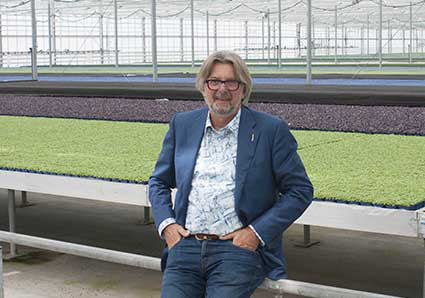
A: I suggest Koppert Cress, headquartered in Monster in the Westland area, as a great example of an innovative company, and managing director Rob Baan is a true entrepreneur. He discovers and grows around 65 different varieties of cress from around the world with a dramatic range of flavor profiles, developing vegetables that surprisingly taste like oysters, wasabi, cinnamon, etc.
The company’s glass-house production system is innovative with light technology. But also the way the company deals with customers and the supply chain is very innovative. The company invested $300,000 in a test kitchen, where Rob Baan brings in chefs from all over the world to taste his cresses and experience cress in different recipes, and he asks for their feedback to innovate further.
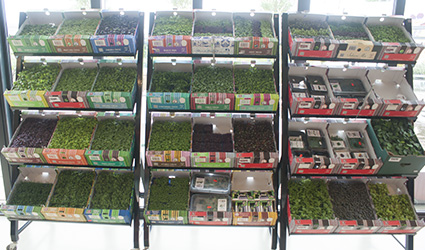
[photos by Julia Seltzer of PRODUCE BUSINESS magazine]
Rob Baan is a strong advocate of linking produce to health and reducing illnesses and medical costs by focusing on prevention, fighting against the corporate food giants like Coca-Cola and Mars and their big advertising budgets, which often counter that effort. Rob Baan seeks out partners in the medical, science and R&D fields and like-minded companies to further this mission. The Netherlands could play a leading role worldwide in promoting health.
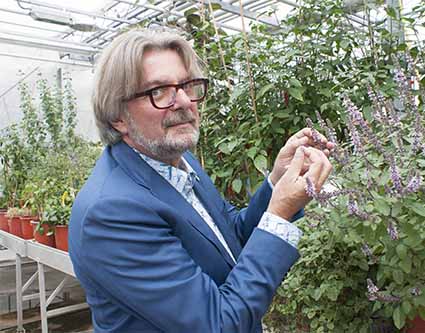
(Editor’s note: Rob Baan, vibrantly welcomed Mira Slott to Koppert Cress operations in Monster. with a memorable, mouth-watering flavor fest sampling of all 65 cress varieties: “You must try Sechuan Buttons,” he says, warning, “It tingles like a 9-volt battery, so many flavors don’t need salt. Here’s Tahoon Cress, pretend it’s raining in the forest and you pick a mushroom and find a small nut on the ground…the full flavor of a fresh pea. Atsina Cress tastes like licorice bits and goes well with dessert…Adji, wait for odd sensation in the middle of your tongue, and breath in the perfumed aroma of jasmine in this variety.” One cress sample tastes bizarrely like camembert cheese, another, the skin of an orange, yet another duplicates the flavor of coriander from Baan’s days in India.
Baan says he has traveled to 121 countries on his global quest for cress. “Most chef’s think there are maybe 10 or 20 varieties,” says Baan, who invites international chefs into his test kitchen weekly to do training, and brainstorm recipes and techniques using cress to bring added value to the dish. “We supply 70,000 restaurants with cress per week,” he says. Koppert Cress has four different greenhouses in the Westland region, “the center of the world for produce,” he says. “We started with four varieties, and are now up to 65, adding five new varieties every year.” ]
Tomato World Westland is another inventive venture. We still produce tomatoes for consumption, but competition is tough with Turkey, Mexico and China. What makes our tomato sector unique is innovation. [Editor’s note: see the story of Mira’s visit to Tomato World]
Wageningen Bleiswijk University and Research, based in Bleiswijk with branches throughout the Netherlands and abroad, is recognized all over the world for its ground-breaking R&D in food and food production, living environment, health, lifestyle and livelihood. Greenhouse Horticulture of Wageningen Plant Research in Bleiswijk is an independent greenhouse site of the University reserved for research.
Q: How does your multiple sector approach help produce companies reach their goals?
A: GroentenFruit Huis, an excellent produce trade organization for Holland based in Zoetemeer, NL, specifically represents and promotes the fresh fruit and vegetable sector. [Editor’s note: more on Groentenfruit Huis to come]. Sectors we serve include and cross over to the produce industry and branch out to clean technology, oil & gas, renewables, maritime and offshore producers, life science and health, smart industries and IT, etc.
The Rotterdam area offers a diverse agro-food cluster and is home to many multinational and national companies, as well as specialized operations, spanning greenhouse horticulture [Dutch greenhouses cover an area of more than 60 kilometers], commodity traders, wholesale, hospitality and retail, agro logistics and transport, food production processing, packaging and R&D centers.
Q: What advantages does Rotterdam bring to produce companies?
A: The strategic location is by far Number 1. It has excellent infrastructure and accessibility from port, rail, highways and airports as well as expert service providers, a highly educated workforce, low business costs, favorable tax climate, and an open and international business climate.
Rotterdam is the gateway to Europe with the biggest seaport in Europe, and the deepest seaport in the world, providing access to even the largest vessels. Rotterdam used to be Number 1 in the world. Around 10 years ago, ports in China & Singapore took over that distinction, but if business is good there, it’s good for us because of the interconnecting shipping lines.
Whether from South Africa, Israel, or South America, global trade is far-reaching. Just from Chile, 300,000 tons of produce a year stream through the Netherlands via the port in Rotterdam. When I visited The Association of Fresh Fruit Exporters in Chile, they shared these numbers with me.
Q: Could you highlight the range of global produce companies setting up locations here?
A: Recently I did a presentation for producers from Michoacán, a State in Mexico, representing 1,300 growers mainly of avocados. UPME (United Producers of Michoacán) opened a marketing office in Rotterdam last June to transport avocados to the rest of Europe. Their main objective is to explore new markets in Europe, and since the goods are transported through the port of Rotterdam to be closer to their markets.
Camposol, a big producer of fresh products in Peru, also has an office in our area.
Another fresh produce firm Jolly Food Industries from Egypt recently opened an office here to enter the European market.
Q: How does Rotterdam Partners work with these companies?
A: We are paid by the Dutch government, both local and national, and stay neutral and objective. What we do for these companies is advise them on what is needed to set up business, and provide help on subsidiary transfers, labor, hiring/contracts, service providers, renting warehouses, legal and tax issues, etc.
The Netherlands is very mild on corporate income tax, among a range of tax advantages and incentives that make it attractive for foreign companies to locate operations here and invest in the Netherlands. It could be expatriots deciding to sell, work here, get immigration permits, schools for their children, etc. Our service is free of charge.
The Netherlands is small, with a population of 17 million people. We have 700,000 inhabitants in Rotterdam and 1.2 million in the metro area, but we’re the agro-food delta of Europe, where major European rivers flow into the North Sea. We’re the second largest exporter of agro-food products in the world, the U.S. being Number 1.
Q: Could you share more about the logistics side for produce?
A: Rotterdam is the logistics hotspot for fresh fruit and vegetables. The Port of Rotterdam is Europe’s premier port for refrigerated and frozen cargo. It’s close to Greenports of Westland and Barendrecht and has excellent multimodal hinterland connections to and from other greenports, and a wide range of state-of the art container terminals. The port offers an extensive network of short sea, inland shipping, rail and road facilities and transshipment options, reaching big markets scattered all over Germany (sometimes more efficiency than if a company goes through the Port of Hamburg), the UK, countries across Eastern Europe and the Middle East.
Barendrecht/Ridderkerk, west of the port, you’ll find a cluster of over 50 agro-food trade and wholesale companies, including Total Produce, the Greenery, Olympic Fruit, Bakker Barendrecht, Holland,Nature’s Pride, and Van Gelder Groente & Fruit. Olam International, a big commodity trader of nuts, spices and cocoa, uses the Netherlands as its distribution hub to Mainland Europe.
The Port of Rotterdam Authority and Kloosterboer, a logistics provider for temperature-controlled food products invested in developing Rotterdam Cool Port, a new cold storage cluster specializing in the storage and handling of refrigerated and frozen cargo in reefer containers, and accompanying services.
Rotterdam Cool Port, under construction now, is bringing together high-tech facilities, docks, cold storage and logistics providers. Total Produce is a launching partner in the venture with Kloosterboer, and other companies are involved too. [Editor’s note: Mira arranged a trip to meet with Michel Jansen, managing director of Total Produce BV, to learn more: “This is a major shift in our strategic direction. We are able to increase our services by outsourcing to a big logistics provider, and sharing in the strengths and benefits of this multi-model hub, to focus on our core business expertise, marketing and distributing fruit”].
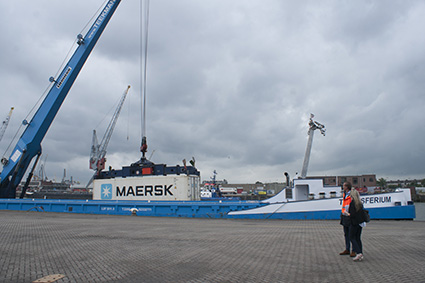
ROTTERDAM PORT ACTION: After visiting with Michel Jansen, managing director of Total Produce, BV, based in Rotterdam, Lennart Visser, manager sustainability and marketing, gives Pundit investigator and special projects editor Mira Slott an operations tour, including a first-hand look at produce getting loaded on a barge. “Total Produce BV is one of the largest specialists importing fresh produce from the U.S., Central America, South America, Africa, and distributing to North and North Western Europe,” says Jansen. [photo by Julia Seltzer of PRODUCE BUSINESS magzine]
Near the Market Hall, on the South Bank, another food hall development with an emphasis on fresh produce is underway. The Fenix Food Factory, a new food hub started by seven Rotterdam food entrepreneurs in a gentrified old warehouse building, is setting the stage for the area’s further transformation with fresh food markets, restaurants, hotels and also a focus on local foods, shortening the ecological footprint and giving a stage to local producers in the area; set to open in 2017.
Rebuilding is inextricably linked to Rotterdam. Rotterdam is all about perseverance, work ethic and action, according to Rene’s associate, Catherine Kalamidas, Account Manager, Congresses, Convention Bureau, at Rotterdam Partners.
A Q&A seemed fitting to garner her thoughts on why:
 Catherine Kalamidas
Catherine Kalamidas
Account Manager Congresses
Convention Bureau, Rotterdam Partners
Q: Many Rotterdam residents express unyielding loyalty to the city, and often at the expense of Amsterdam. Why is that?
A: There is a lot of rivalry between Amsterdam and Rotterdam, and it does start with football, and friendly ribbing going on. Amsterdam doesn’t need to work on investment like we do in Rotterdam. There’s a kneejerk reaction to think of Amsterdam first.
We work hard for that recognition. There is a very tough work ethic here historically because of bombing in World War II. Rotterdam was obliterated, the need to reinvent itself after the war is still going on; there are active re-building periods and then it gets quiet.
We’re just coming out of a rebuilding, celebrating 20 years since the 1996 opening of the Erasmus Bridge. Locals call it the Swan. We give nicknames to everything. The Erasmus Bridge, created by Dutch architect Ben van Berkel, is a stunning representation of the city’s forward-thinking architectural design aesthetic [The asymmetrical bridge is 800 meters long and has a 139 meter high pylon which is fastened by 32 stays.]
People who live here are fiercely proud of Rotterdam. Certain expressions exemplify that.
Q: Nic Jooste at Cool Fresh International in Ridderkerk, NL, shared his favorite Dutch sayings. What are some of yours?
A: Sterker door Strijd: Stronger through Struggle, refers to the struggle to rebuild the city after it was decimated during WWII. The motto was officially made a Rotterdam motto by the Queen at the time. Some also say it is referring to the ages-long struggle to hold back the sea. If you look at historical maps of the Netherlands, you will see that the land surface has grown, so existent land was protected, and new land reclaimed from the sea.
In Rotterdam this is very obvious, and the best tech exists in the region in terms of sea barriers etc. Rotterdammers have been called on to use their expertise to protect New Orleans and New York City.
Q: In what other ways is America connected to Rotterdam?
A: I’m from New York. There have always been strong ties here to America. One of the first ships that came to Rotterdam after the War through the Marshall Plan carried baseball equipment. Baseball has a long tradition here. It’s a niche sport, and the Dutch who play are fanatics. The proof is in the fact the Dutch team won the World Baseball Classic in 2011. My son was part of Holland’s National Junior League baseball team, and went on to compete for the international title in Poland. They didn’t win, but were proud to represent Holland, in this traditionally American pastime.
Rotterdam’s urban skylines of majestic high rise buildings earned it the epithet Manhattan on the Maas. People look like they’re lost in Rotterdam, but it’s because they’re looking up at the innovative architecture.
Another Dutch expression Niet lullen, maar poetsen, basically means don’t be idle, get polishing. I think this just reflects the work ethic of Rotterdam, obviously reinforced by the industrious atmosphere of the harbour. It really is about rolling up your sleeves and just getting the job done. That’s what we do here.
Geen woorden, maar daden literally means not just words, but rather deeds. In today’s world, don’t just speak of what you are going to do, but actually do it.
Q: In that regard, tell us more about the rebuilding of Rotterdam and why people should take notice…
A: The main thing is that Rotterdam had a blank canvas after the heavy bombing in the war and could re-plan the city. Notice the bicycle paths are so well defined and safe. In other areas, the paths are scattered, sometimes just a dotted line dividing the cyclists from traffic. In Rotterdam, planners created the boulevards, linking the points — Central Station to the waterfront.
It’s a compact city, very well connected; it’s modern but has a touch of history, public transportation is easy to use, and it’s very clean and safe. A lot of people think Rotterdam is too far from Schiphol Airport, but it’s only 35 minutes by car and 25 minutes by train.
Rotterdam Partners is a very unique model in the city, where we’ve bundled together mindsets. As colleagues, we specialize in different areas. Rene is focusing on investment, for instance, and I’m on conferences, but the goals overlap.
Rotterdam is a city hub for the sector. It has a wide scope that crosses over to the medical nutrition side, and logistics and transport with the harbor. Our mayor has identified food, water and energy as a holy trinity here.
Most people who attend shows and conferences are well traveled and have been everywhere, all the major cities. It’s nice to visit someplace different. Rotterdam offers something fresh and new.
********
If Amsterdam is the global beacon of the Netherlands and custodian of its heritage, Rotterdam, with the brawny shoulders of one who had to rebuild after the bombing of World War II flattened the city is a source of industrial strength.
Today it takes both to have a balanced economy and visitors to The Amsterdam Produce Show and Conference are fortunate to not have to choose. You can see both
So look here to learn about the Agro Merchants tour.
If you want to register for the tour or require more information just let us know here.
You can register for the show here.
If you want a hotel room in the headquarters hotel then let us know your requirements here.
In any case come and network, learn and do business at The Amsterdam Produce Show and Conference then see this incredible country, meet the incredible citizens of the nation and visit the incredible industry spread across this small but extraordinarily important land at the very heart of the produce industry.










